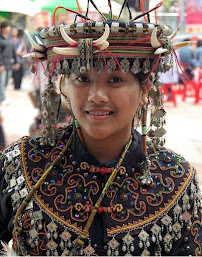As a sequel to the Following folktales around the world reading challenge, I decided to start reading minority and indigenous folktales. First up are the minority peoples who live in Asia. You can find previous posts here, and you can follow the challenge on Facebook here.
Studies in Hakka folktales
Wolfram Eberhard
Chinese Association for Folklore, 1974.
Who's next?
Chinese Association for Folklore, 1974.
The Hakka are not one of the 55 recognized ethnic minorities of China; they are considered a subgroup of the Han Chinese, but they are clearly defined in their cultural and linguistic identity; their population numbers somewhere between 80 and 100 million. The tales of this book were collected from the Hakka communities of Taiwan in the 1970s (many of whom migrated to the island from Fujian Province in China). The collectors interviewed more than 500 people, none of them storytellers, seeking answers to research question such as "how do folktales reflect the values of a community?" and "what are the most popular tales among the Hakka?"
According to the collector, folktale books often focus on the unique repertoires of highly talented storytellers, and therefore they don't necessarily reflect the full array of stories a community has. He wanted to know what the most liked and generally known folktales are among the Hakka, and how they reflect cultural values. To this goal, many Hakka people were interviewed with specific questionnaires, including a wide range: young and old, women and men, urban and rural informants were equally represented in the sample. The book's introduction describes the project in great detail with numbers and statistics. It introduces the most common genres (e.g. myths, legends), the values most often mentioned (honesty, filial piety, kindness, etc.), the possible sources of the tales, and people's opinions on them. The research project included more than 500 stories.
The tales themselves are embedded into analysis and academic discussion throughout the book; some of them are published in more than one version for comparison. The author compares their popularity to their Chinese counterparts, and references the Chinese folktale type index. Later on the researchers also interviewed talented storytellers (although still excluded the professional ones), to compare their repertoire to the communities'. This two-pronged approach was used to delineate a full picture of Hakka folktales in Taiwan.
At the end of the book there is a list of the stories with titles, type numbers, and two-line summaries - which to me as a storyteller was equal parts fascinating and frustrating.
Highlights
I was intrigued by the tale in which a theater play was interrupted by a ghost. The ghost approached the actor portraying the legendary Judge Pao, asking for justice in his own murder. The actor remained in character, and the murder was solved. Otherwordly justice also figured into the story where a poor man lodged a complaint against Yenlo Wang, ruler of the Underworld, for assigning him a miserable fate. With his persistence, he managed to convince the deity to rewrite his fate.
I liked the stories about the grateful bees who helped a person who rescued them; and also the legend of Pan-pien Mountain, in which an old man was giving away baskets of dumplings for free, and rewarded the one kind young man who insisted on paying a fair price anyway. Kindness also featured into the story of In the light and In the dark, which started out as a rich brother-poor brother tale, but the brothers mutually supported and helped each other instead of fighting.
The legend of the daffodils was especially lovely. The gods gifted an ever-blooming daffodil field to a poor boy who lost his inheritance.
Connections
After the Zhuang tales I once again encountered the delightful "fragrant farts" folktale type. Among other classics there was a version of the legend of the Weaver Girl and the Cowherd, the origin of the animal zodiac, and also the story where a father makes his sons dig up the garden by promising them buried treasure. I was happy to see a new variant for the Chinese story of the friendship of a fisherman and a ghost. There were some stories of possibly Japanese origin, such as Urashima Taro, and the eight-headed dragon defeated by Susanoo.
Some common folktale types also appeared in the collection, such as Aladdin (with the grateful cat and dog who ended up hating each other), golden ax, kind and unkind girls (Big Gold and Little Gold), animal husband (here a snail, who ended up reclaiming his stolen snail shell in an Aladdin-like story), and Fortunatus (here three young men adopted an old beggar as their father, and received magic items from him).
Among the trickster figures there was a monkey (who usually messed up his tricks), and a clever young scholar named Li Wen-ku.
Who's next?
The Tujia people



No comments:
Post a Comment